Environmental Impact of Different Business Models: An LCA Study of Fresh Tomato Production in Italy
Abstract
:1. Introduction
2. Business Model Innovation
3. Types of Production
3.1. Standard Production
3.2. Integrated Production
3.3. Advanced Agronomic Techniques: Precision Farming
4. Methodology
4.1. Goal and Scope
4.2. System Boundaries
4.3. Inventory and Impact Assessment
5. Results
5.1. Life Cycle Impact Assessment
5.2. Endpoint Results
5.3. Carbon Footprint
6. Discussion and Implications
6.1. Theoretical Discussions and Implications
6.2. Managerial Discussion and Implications
7. Conclusions and Implications
Supplementary Materials
Author Contributions
Funding
Institutional Review Board Statement
Informed Consent Statement
Data Availability Statement
Conflicts of Interest
References
- Notarnicola, B.; Sala, S.; Anton, A.; McLaren, S.J.; Saouter, E.; Sonesson, U. The Role of Life Cycle Assessment in Supporting Sustainable Agri-Food Systems: A Review of the Challenges. J. Clean. Prod. 2017, 140, 399–409. [Google Scholar] [CrossRef]
- Calero, M.; Clemente, G.; Fartdinov, D.; Bañón, S.; Muñoz, I.; Sanjuán, N. Upscaling via a Prospective LCA: A Case Study on Tomato Homogenate Using a Near-to-Market Pasteurisation Technology. Sustainability 2022, 14, 1716. [Google Scholar] [CrossRef]
- Lazonick, W. The New Economy Business Model and Sustainable Prosperity. SSRN Electron. J. 2008, 1–35. [Google Scholar] [CrossRef] [Green Version]
- Massa, L.; Tucci, C.L.; Afuah, A. A Critical Assessment of Business Model Research. Acad. Manag. Ann. 2017, 11, 73–104. [Google Scholar] [CrossRef]
- Montanarella, L.; Panagos, P. The Relevance of Sustainable Soil Management within the European Green Deal. Land Use Policy 2021, 100, 104950. [Google Scholar] [CrossRef]
- Pe’er, G.; Finn, J.A.; Díaz, M.; Birkenstock, M.; Lakner, S.; Röder, N.; Kazakova, Y.; Šumrada, T.; Bezák, P.; Concepción, E.D.; et al. How Can the European Common Agricultural Policy Help Halt Biodiversity Loss? Recommendations by over 300 Experts. Conserv. Lett. 2022, 15, e12901. [Google Scholar] [CrossRef]
- Zaborowska, M.; Bernat, K.; Pszczółkowski, B.; Wojnowska-Baryła, I.; Kulikowska, D. Anaerobic Degradability of Commercially Available Bio-Based and Oxo-Degradable Packaging Materials in the Context of Their End of Life in the Waste Management Strategy. Sustainability 2021, 13, 6818. [Google Scholar] [CrossRef]
- Pushkar, S. Life-Cycle Assessment of LEED-CI v4 Projects in Shanghai, China: A Case Study. Sustainability 2023, 15, 5722. [Google Scholar] [CrossRef]
- Del Borghi, A.; Gallo, M.; Strazza, C.; Del Borghi, M. An Evaluation of Environmental Sustainability in the Food Industry through Life Cycle Assessment: The Case Study of Tomato Products Supply Chain. J. Clean. Prod. 2014, 78, 121–130. [Google Scholar] [CrossRef]
- Sica, D.; Esposito, B.; Malandrino, O.; Supino, S. The Role of Digital Technologies for the LCA Empowerment towards Circular Economy Goals: A Scenario Analysis for the Agri-Food System. Int. J. Life Cycle Assess. 2022, 1–24. [Google Scholar] [CrossRef]
- Borghesi, G.; Stefanini, R.; Vignali, G. Life Cycle Assessment of Packaged Organic Dairy Product: A Comparison of Different Methods for the Environmental Assessment of Alternative Scenarios. J. Food Eng. 2022, 318, 110902. [Google Scholar] [CrossRef]
- Colucci, V.; Manfrida, G.; Mendecka, B.; Talluri, L.; Zuffi, C. LCA and Exergo-Environmental Evaluation of a Combined Heat and Power Double-Flash Geothermal Power Plant. Sustainability 2021, 13, 1935. [Google Scholar] [CrossRef]
- Sestino, A.; Rossi, M.V.; Giraldi, L.; Faggioni, F. Innovative Food and Sustainable Consumption Behaviour: The Role of Communication Focus and Consumer-Related Characteristics in Lab-Grown Meat (LGM) Consumption. Br. Food J. 2023; ahead-of-print. [Google Scholar] [CrossRef]
- Jestratijevic, I.; Uanhoro, J.O.; Creighton, R. To Disclose or Not to Disclose? Fashion Brands’ Strategies for Transparency in Sustainability Reporting. J. Fash. Mark. Manag. Int. J. 2022, 26, 36–50. [Google Scholar] [CrossRef]
- Bozkurt, S.; Gligor, D.; Gligor, N. Investigating the Impact of Psychological Customer Engagement on Customer Engagement Behaviors: The Moderating Role of Customer Commitment. J. Mark. Anal. 2022, 10, 408–424. [Google Scholar] [CrossRef]
- Rietveld, R.; Van Dolen, W.; Mazloom, M.; Worring, M. What You Feel, Is What You like Influence of Message Appeals on Customer Engagement on Instagram. J. Interact. Mark. 2020, 49, 20–53. [Google Scholar] [CrossRef]
- Sun, Y.; Bao, Q.; Taghizadeh-Hesary, F. Green Finance, Renewable Energy Development, and Climate Change: Evidence from Regions of China. Hum. Soc. Sci. Commun. 2023, 10, 107. [Google Scholar] [CrossRef] [PubMed]
- Lemoine, G.J.; Eva, N.; Meuser, J.D.; Falotico, P. Organizational Performance with a Broader Focus: The Case for a Stakeholder Approach to Leadership. Bus. Horiz. 2021, 64, 401–413. [Google Scholar] [CrossRef]
- Sigel, A. CSR statements: Incentives and enforcement in the wake of the business roundtable’s statement on corporate purpose. Boston Univ. Law Rev. 2021, 101, 803–833. [Google Scholar]
- López Nevárez, V.; Zavala Féliz, B.D. La Responsabilidad Social En Las Dimensiones de La Ciudadanía Corporativa. Un Estudio de Caso En La Manufactura Agrícola. CIRIEC-España Rev. Econ. Pública Soc. Coop. 2019, 97, 179–211. [Google Scholar] [CrossRef]
- Degieter, M.; Gellynck, X.; Goyal, S.; Ott, D.; De Steur, H. Life Cycle Cost Analysis of Agri-Food Products: A Systematic Review. Sci. Total Environ. 2022, 850, 158012. [Google Scholar] [CrossRef] [PubMed]
- Bojacá, C.R.; Wyckhuys, K.A.G.; Schrevens, E. Life Cycle Assessment of Colombian Greenhouse Tomato Production Based on Farmer-Level Survey Data. J. Clean. Prod. 2014, 69, 26–33. [Google Scholar] [CrossRef]
- Naseer, M.; Persson, T.; Hjelkrem, A.-G.R.; Ruoff, P.; Verheul, M.J. Life Cycle Assessment of Tomato Production for Different Production Strategies in Norway. J. Clean. Prod. 2022, 372, 133659. [Google Scholar] [CrossRef]
- Bosona, T.; Gebresenbet, G. Life Cycle Analysis of Organic Tomato Production and Supply in Sweden. J. Clean. Prod. 2018, 196, 635–643. [Google Scholar] [CrossRef]
- Tell, J.; Hoveskog, M.; Ulvenblad, P.; Ulvenblad, P.-O.; Barth, H.; Ståhl, J. Business Model Innovation in the Agri-Food Sector: A Literature Review. Br. Food J. 2016, 118, 1462–1476. [Google Scholar] [CrossRef]
- Knierim, A.; Boenning, K.; Caggiano, M.; Cristóvão, A.; Dirimanova, V.; Koehnen, T.; Labarthe, P.; Prager, K. The AKIS Concept and Its Relevance in Selected EU Member States. Outlook Agric. 2015, 44, 29–36. [Google Scholar] [CrossRef]
- Knierim, A.; Kernecker, M.; Erdle, K.; Kraus, T.; Borges, F.; Wurbs, A. Smart Farming Technology Innovations—Insights and Reflections from the German Smart-AKIS Hub. NJAS Wagening. J. Life Sci. 2019, 90–91, 100314. [Google Scholar] [CrossRef]
- Seo, J.; Lee, J.; Jung, S.; Park, S. The Role of Creating Shared Value and Entrepreneurial Orientation in Generating Social and Economic Benefits: Evidence from Korean SMEs. Sustainability 2023, 15, 6168. [Google Scholar] [CrossRef]
- Lencsés, E.; Mészáros, K. Business Model Innovation with Precision Farming Technology from the Farmers Point of View. Hung. Agric. Eng. 2020, 8, 79–81. [Google Scholar] [CrossRef]
- Rose, D.C.; Chilvers, J. Agriculture 4.0: Broadening Responsible Innovation in an Era of Smart Farming. Front. Sustain. Food Syst. 2018, 2, 87. [Google Scholar] [CrossRef] [Green Version]
- Kovács, I.; Husti, I. The Role of Digitalization in the Agricultural 4.0—How to Connect the Industry 4.0 to Agriculture? Hung. Agric. Eng. 2018, 33, 38–42. [Google Scholar] [CrossRef]
- Lazonick, W. Innovative Business Models and Varieties of Capitalism: Financialization of the U.S. Corporation. Bus. Hist. Rev. 2010, 84, 675–702. [Google Scholar] [CrossRef] [Green Version]
- Sutherland, L.-A.; Adamsone-Fiskovica, A.; Elzen, B.; Koutsouris, A.; Laurent, C.; Stræte, E.P.; Labarthe, P. Advancing AKIS with Assemblage Thinking. J. Rural Stud. 2023, 97, 57–69. [Google Scholar] [CrossRef]
- Thomson, L. Leveraging the Value from Digitalization: A Business Model Exploration of New Technology-Based Firms in Vertical Farming. J. Manuf. Technol. Manag. 2022, 33, 88–107. [Google Scholar] [CrossRef]
- Massa, L.; Tucci, C.L. Business Model Innovation; Oxford University Press: Oxford, UK, 2014. [Google Scholar]
- Mitchell, D.W.; Bruckner Coles, C. Business Model Innovation Breakthrough Moves. J. Bus. Strategy 2004, 25, 16–26. [Google Scholar] [CrossRef]
- Lindgardt, Z.; Reeves, M.; Stalk, G., Jr.; Deimler, M. Business Model Innovation: When the Game Gets Tough, Change the Game. In Own the Future; Wiley: Hoboken, NJ, USA, 2012; pp. 291–298. [Google Scholar]
- Amit, R.; Zott, C. Creating Value Through Business Model Innovation. MIT Sloan Manag. Rev. 2012, 53, 41–49. [Google Scholar]
- Schnebelin, É. Linking the Diversity of Ecologisation Models to Farmers’ Digital Use Profiles. Ecol. Econ. 2022, 196, 107422. [Google Scholar] [CrossRef]
- Lampropoulos, G.; Siakas, K.; Anastasiadis, T. Internet of Things in the Context of Industry 4.0: An Overview. Int. J. Entrep. Knowl. 2019, 7, 4–19. [Google Scholar] [CrossRef]
- Pallavi, B.; Othman, B.; Trivedi, G.; Manan, N.; Pawar, R.S.; Singh, D.P. The Application of the Internet of Things (IoT) to Establish a Technologically Advanced Industry 4.0 for Long-Term Growth and Development. In Proceedings of the 2022 2nd International Conference on Advance Computing and Innovative Technologies in Engineering (ICACITE), Greater Noida, India, 28–29 April 2022; pp. 1927–1932. [Google Scholar]
- Silverio-Fernández, M.; Renukappa, S.; Suresh, S. What Is a Smart Device?—A Conceptualisation within the Paradigm of the Internet of Things. Vis. Eng. 2018, 6, 3. [Google Scholar] [CrossRef] [Green Version]
- Sestino, A.; Prete, M.I.; Piper, L.; Guido, G. Internet of Things and Big Data as Enablers for Business Digitalization Strategies. Technovation 2020, 98, 102173. [Google Scholar] [CrossRef]
- Tao, F.; Qi, Q.; Wang, L.; Nee, A.Y.C. Digital Twins and Cyber–Physical Systems toward Smart Manufacturing and Industry 4.0: Correlation and Comparison. Engineering 2019, 5, 653–661. [Google Scholar] [CrossRef]
- Killeen, P.; Ding, B.; Kiringa, I.; Yeap, T. IoT-Based Predictive Maintenance for Fleet Management. Procedia Comput. Sci. 2019, 151, 607–613. [Google Scholar] [CrossRef]
- Boye, J.I.; Arcand, Y. Current Trends in Green Technologies in Food Production and Processing. Food Eng. Rev. 2013, 5, 1–17. [Google Scholar] [CrossRef] [Green Version]
- Mazzucato, M.; Shipman, A. Accounting for Productive Investment and Value Creation. Ind. Corp. Chang. 2014, 23, 1059–1085. [Google Scholar] [CrossRef] [Green Version]
- Cellura, M.; Ardente, F.; Longo, S. From the LCA of Food Products to the Environmental Assessment of Protected Crops Districts: A Case-Study in the South of Italy. J. Environ. Manag. 2012, 93, 194–208. [Google Scholar] [CrossRef] [PubMed]
- Heller, M.C.; Keoleian, G.A.; Willett, W.C. Toward a Life Cycle-Based, Diet-Level Framework for Food Environmental Impact and Nutritional Quality Assessment: A Critical Review. Environ. Sci. Technol. 2013, 47, 12632–12647. [Google Scholar] [CrossRef]
- Martínez-Blanco, J.; Muñoz, P.; Antón, A.; Rieradevall, J. Assessment of Tomato Mediterranean Production in Open-Field and Standard Multi-Tunnel Greenhouse, with Compost or Mineral Fertilizers, from an Agricultural and Environmental Standpoint. J. Clean. Prod. 2011, 19, 985–997. [Google Scholar] [CrossRef]
- Torrellas, M.; Antón, A.; López, J.C.; Baeza, E.J.; Parra, J.P.; Muñoz, P.; Montero, J.I. LCA of a Tomato Crop in a Multi-Tunnel Greenhouse in Almeria. Int. J. Life Cycle Assess. 2012, 17, 863–875. [Google Scholar] [CrossRef]
- Page, G.; Ridoutt, B.; Bellotti, B. Carbon and Water Footprint Tradeoffs in Fresh Tomato Production. J. Clean. Prod. 2012, 32, 219–226. [Google Scholar] [CrossRef]
- Dias, G.M.; Ayer, N.W.; Khosla, S.; Van Acker, R.; Young, S.B.; Whitney, S.; Hendricks, P. Life Cycle Perspectives on the Sustainability of Ontario Greenhouse Tomato Production: Benchmarking and Improvement Opportunities. J. Clean. Prod. 2017, 140, 831–839. [Google Scholar] [CrossRef]
- Winans, K.; Brodt, S.; Kendall, A. Life Cycle Assessment of California Processing Tomato: An Evaluation of the Effects of Evolving Practices and Technologies over a 10-Year (2005–2015) Timeframe. Int. J. Life Cycle Assess. 2020, 25, 538–547. [Google Scholar] [CrossRef] [Green Version]
- De Marco, I.; Riemma, S.; Iannone, R. Uncertainty of Input Parameters and Sensitivity Analysis in Life Cycle Assessment: An Italian Processed Tomato Product. J. Clean. Prod. 2018, 177, 315–325. [Google Scholar] [CrossRef]
- Guidi, E.; Albonetti, S. A New Food Chain Approach: Uni EN ISO 22005:2008 Voluntary Certification. Ital. J. Food Saf. 2011, 1, 291. [Google Scholar] [CrossRef]
- Zaragüeta, A.; Enrique, A.; Portell, X.; Antón, R.; Virto, I.; Orcaray, L. A Fertilisation Strategy Combining Mineral Fertiliser and Biosolid Improves Long-Term Yield and Carbon Storage in a Calcareous Soil. Agriculture 2023, 13, 860. [Google Scholar] [CrossRef]
- Finger, R.; Swinton, S.M.; El Benni, N.; Walter, A. Precision Farming at the Nexus of Agricultural Production and the Environment. Annu. Rev. Resour. Econ. 2019, 11, 313–335. [Google Scholar] [CrossRef] [Green Version]
- Ingwersen, W.W.; Stevenson, M.J. Can We Compare the Environmental Performance of This Product to That One? An Update on the Development of Product Category Rules and Future Challenges toward Alignment. J. Clean. Prod. 2012, 24, 102–108. [Google Scholar] [CrossRef]
- Fernandes de Oliveira, A.; Mameli, M.G.; De Pau, L.; Satta, D. Almond Tree Adaptation to Water Stress: Differences in Physiological Performance and Yield Responses among Four Cultivar Grown in Mediterranean Environment. Plants 2023, 12, 1131. [Google Scholar] [CrossRef]
- Tolettini, L.; Di Maria, E. Structuring and Measuring Environmental Sustainability in the Steel Sector: A Single Case Study. Sustainability 2023, 15, 6272. [Google Scholar] [CrossRef]
- Colovic, M.; Yu, K.; Todorovic, M.; Cantore, V.; Hamze, M.; Albrizio, R.; Stellacci, A.M. Hyperspectral Vegetation Indices to Assess Water and Nitrogen Status of Sweet Maize Crop. Agronomy 2022, 12, 2181. [Google Scholar] [CrossRef]
- Vecchio, Y.; Agnusdei, G.P.; Miglietta, P.P.; Capitanio, F. Adoption of Precision Farming Tools: The Case of Italian Farmers. Int. J. Environ. Res. Public Health 2020, 17, 869. [Google Scholar] [CrossRef] [Green Version]
- Vecchio, Y.; De Rosa, M.; Adinolfi, F.; Bartoli, L.; Masi, M. Adoption of Precision Farming Tools: A Context-Related Analysis. Land Use Policy 2020, 94, 104481. [Google Scholar] [CrossRef]
- Barth, H.; Ulvenblad, P.-O.; Ulvenblad, P. Towards a Conceptual Framework of Sustainable Business Model Innovation in the Agri-Food Sector: A Systematic Literature Review. Sustainability 2017, 9, 1620. [Google Scholar] [CrossRef] [Green Version]
- Sauer, J.; Vrolijk, H. Innovation and Performance—Evidence at Micro Level. Appl. Econ. 2019, 51, 4673–4699. [Google Scholar] [CrossRef]
- Yu, S.; Yang, X.; Li, Q.; Zhang, Y.; Zhou, H. Breaking the Temperature Limit of Hydrothermal Carbonization of Lignocellulosic Biomass by Decoupling Temperature and Pressure. Green Energy Environ. 2023; in press. [Google Scholar] [CrossRef]
- Mirabella, N.; Allacker, K.; Sala, S. Current Trends and Limitations of Life Cycle Assessment Applied to the Urban Scale: Critical Analysis and Review of Selected Literature. Int. J. Life Cycle Assess. 2019, 24, 1174–1193. [Google Scholar] [CrossRef]
- Yap, J.B.H.; Skitmore, M. Ameliorating Time and Cost Control with Project Learning and Communication Management. Int. J. Manag. Proj. Bus. 2020, 13, 767–792. [Google Scholar] [CrossRef] [Green Version]
- Arcese, G.; Lucchetti, M.C.; Massa, I.; Valente, C. State of the Art in S-LCA: Integrating Literature Review and Automatic Text Analysis. Int. J. Life Cycle Assess. 2018, 23, 394–405. [Google Scholar] [CrossRef]
- Heijungs, R.; Settanni, E.; Guinée, J. Toward a Computational Structure for Life Cycle Sustainability Analysis: Unifying LCA and LCC. Int. J. Life Cycle Assess. 2013, 18, 1722–1733. [Google Scholar] [CrossRef] [Green Version]
- Notarnicola, B.; Hayashi, K.; Curran, M.A.; Huisingh, D. Progress in Working towards a More Sustainable Agri-Food Industry. J. Clean. Prod. 2012, 28, 1–8. [Google Scholar] [CrossRef]

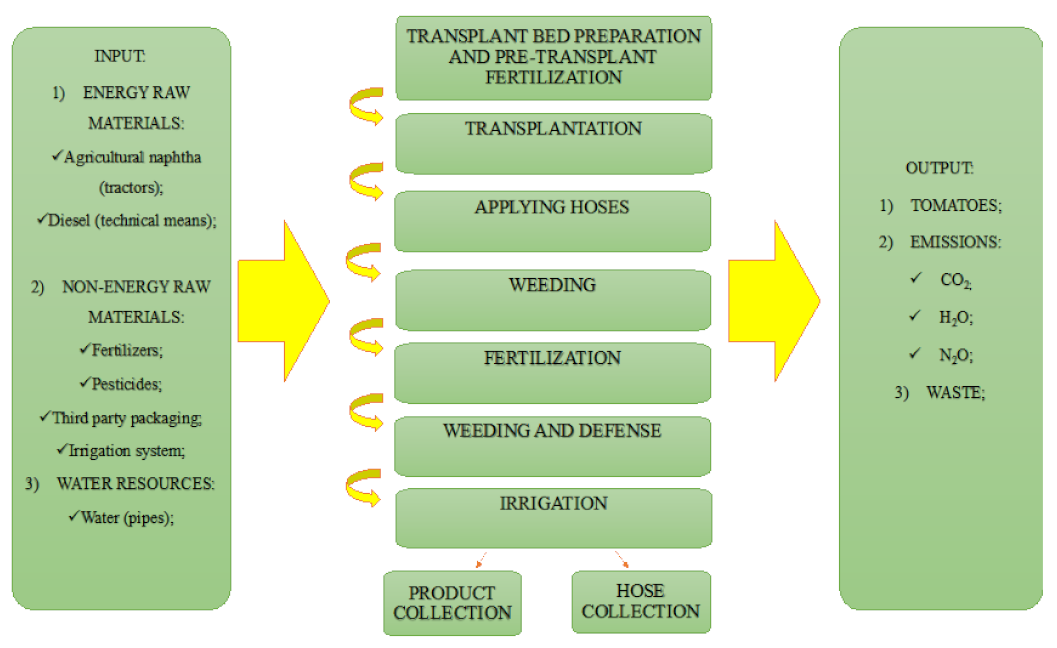
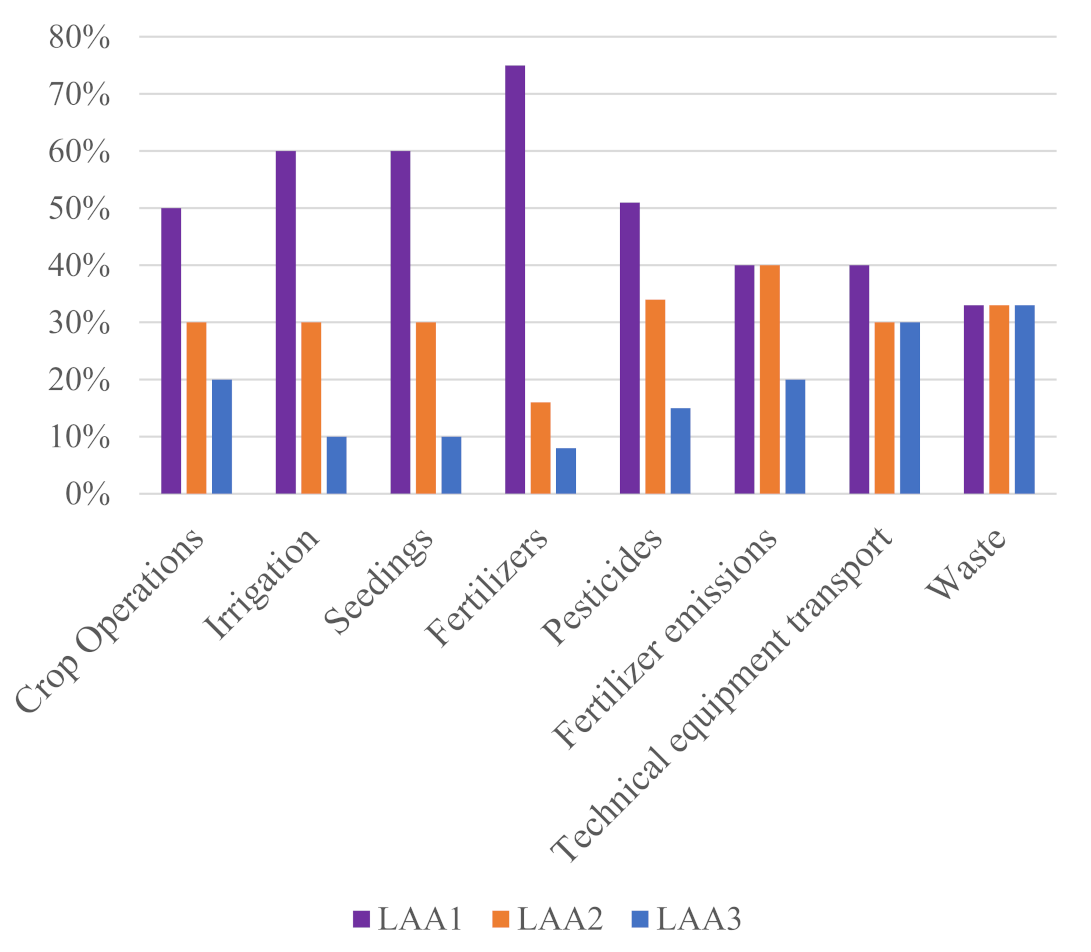
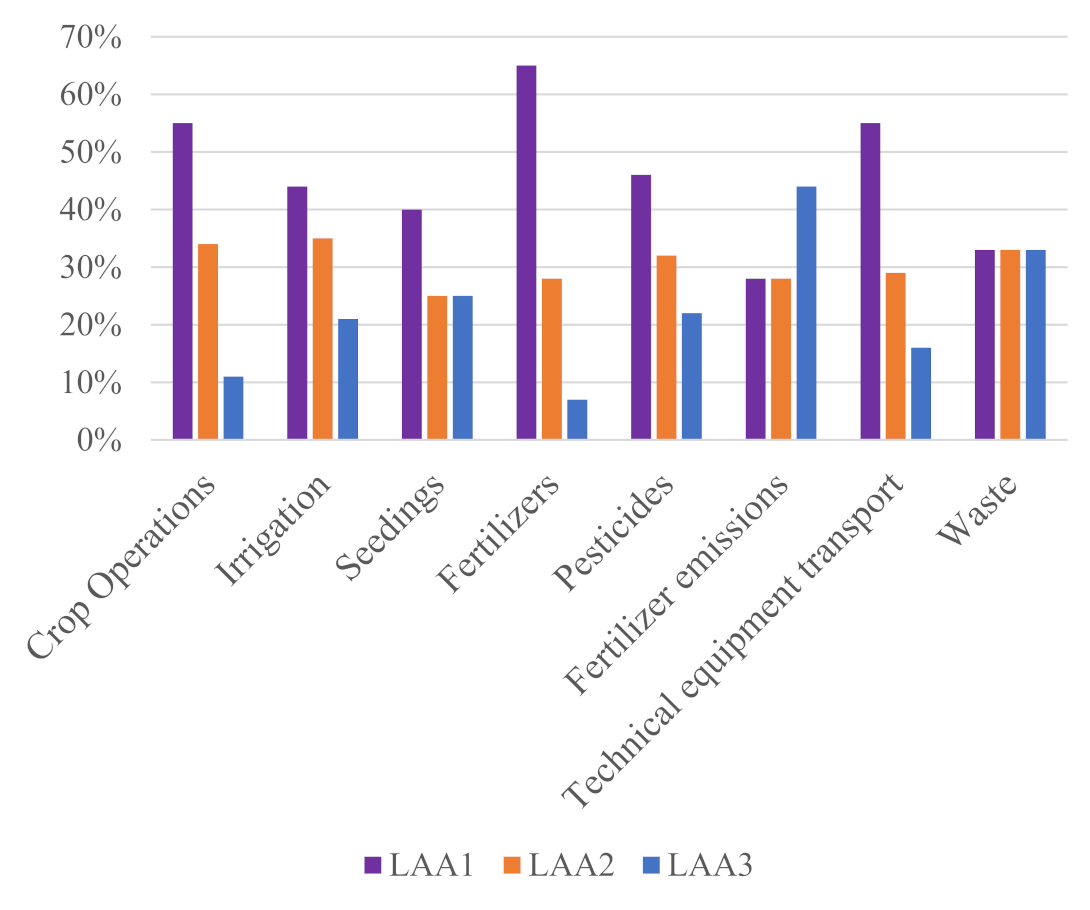

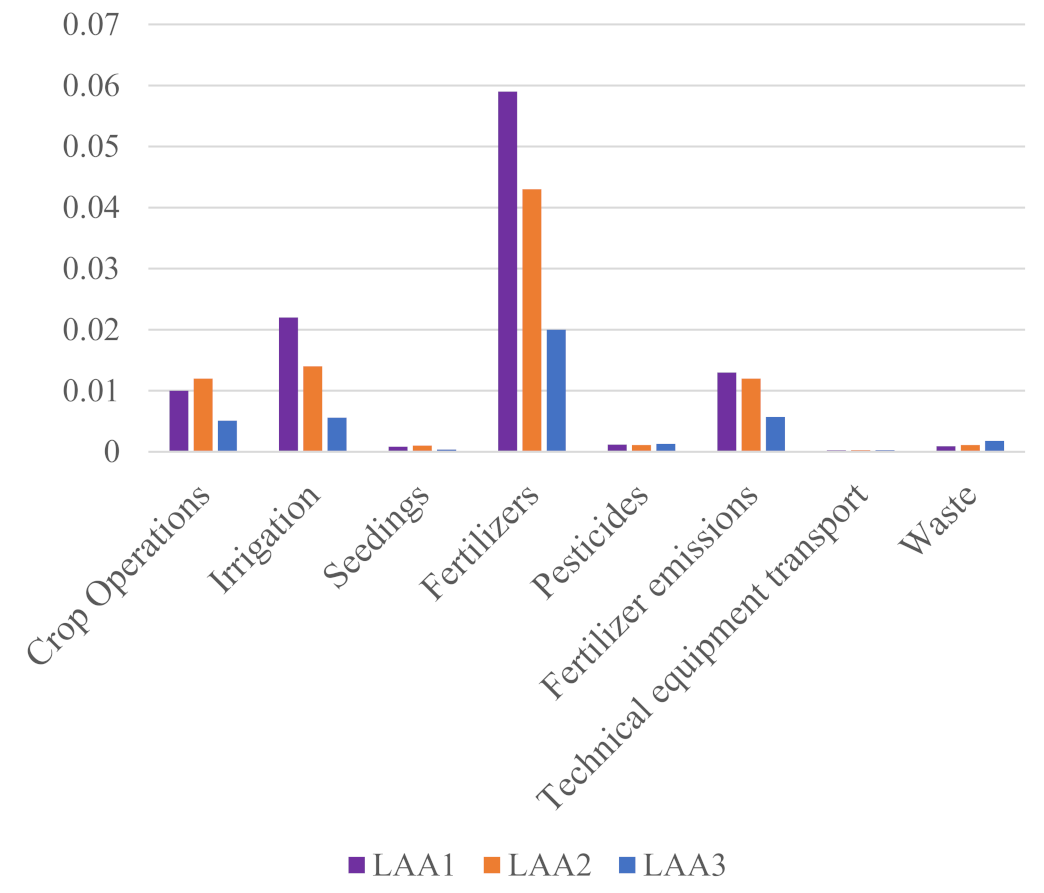
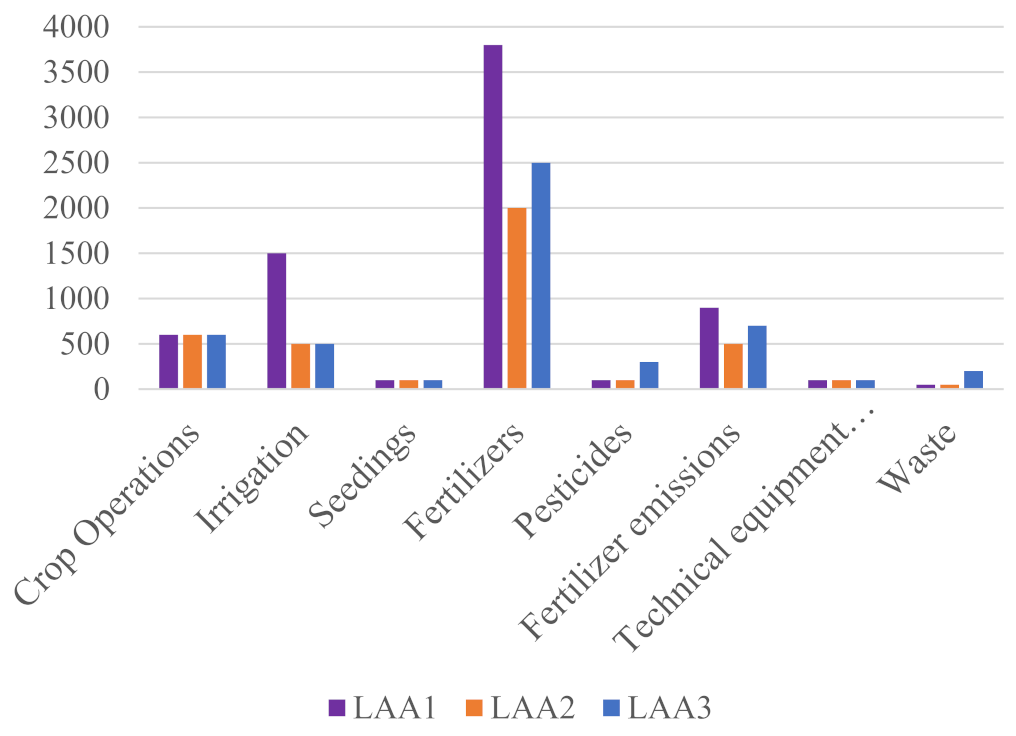
| Classification | Description |
|---|---|
| Cultivation operations | Energy consumption for cultivation operations (tillage, transplantation, fertilization, weeding, phytosanitary treatments, harvesting operations) |
| Irrigation | Energy consumption (pump, spreading, and collection of hoses), irrigation systems (self-propelled sprinkler hose or hoses), and water consumption |
| Seedlings | Production of seedlings plateau |
| Fertilizers | Production of fertilizers and related packaging |
| Pesticides | Production of active ingredients and related packaging |
| Emissions from fertilizer use | Direct and indirect emissions of N2O, NO, NH3 |
| Transport | Transport of seedlings and technical means |
| Waste | Waste disposal (packaging, polystyrene plateau, hoses, self-propelled sprinkler pipe) |
Disclaimer/Publisher’s Note: The statements, opinions and data contained in all publications are solely those of the individual author(s) and contributor(s) and not of MDPI and/or the editor(s). MDPI and/or the editor(s) disclaim responsibility for any injury to people or property resulting from any ideas, methods, instructions or products referred to in the content. |
© 2023 by the authors. Licensee MDPI, Basel, Switzerland. This article is an open access article distributed under the terms and conditions of the Creative Commons Attribution (CC BY) license (https://creativecommons.org/licenses/by/4.0/).
Share and Cite
Solimene, S.; Coluccia, D.; Bernardo, A. Environmental Impact of Different Business Models: An LCA Study of Fresh Tomato Production in Italy. Sustainability 2023, 15, 10365. https://doi.org/10.3390/su151310365
Solimene S, Coluccia D, Bernardo A. Environmental Impact of Different Business Models: An LCA Study of Fresh Tomato Production in Italy. Sustainability. 2023; 15(13):10365. https://doi.org/10.3390/su151310365
Chicago/Turabian StyleSolimene, Silvia, Daniela Coluccia, and Alessandro Bernardo. 2023. "Environmental Impact of Different Business Models: An LCA Study of Fresh Tomato Production in Italy" Sustainability 15, no. 13: 10365. https://doi.org/10.3390/su151310365
APA StyleSolimene, S., Coluccia, D., & Bernardo, A. (2023). Environmental Impact of Different Business Models: An LCA Study of Fresh Tomato Production in Italy. Sustainability, 15(13), 10365. https://doi.org/10.3390/su151310365







